When it comes to healthy and nutritious salad options, fruit salad and vegetable salad are two delicious choices that deserve our attention. As a salad enthusiast, I have explored the flavors, textures, and benefits of both. In this article, I will share my insights and comparisons to help you make the best salad choices for your meals.
Let’s start with fruit salad. Bursting with vibrant colors and natural sweetness, fruit salad is a refreshing and satisfying option, especially during the summer months. Made with a combination of crunchy, tangy, and flavorful fruits, this salad is not only a treat for your taste buds but also a nutritional powerhouse.
On the other hand, vegetable salad provides a different kind of freshness and earthy flavors. Packed with a variety of crisp veggies, it offers a satisfying crunch and a range of essential nutrients. Whether enjoyed as a side dish or a light entree, vegetable salad is a great choice for those looking to incorporate more greens into their diet.
Whether you are a fruit lover or a vegetable enthusiast, both types of salads have their own unique benefits. Fruit salad is rich in vitamins, minerals, and antioxidants, while vegetable salad provides essential fiber, along with additional vitamins and minerals.
Key Takeaways:
- Both fruit salad and vegetable salad are healthy and nutritious options.
- Fruit salad is bursting with vibrant colors and natural sweetness.
- Vegetable salad offers a satisfying crunch and essential nutrients.
- Fruit salad is rich in vitamins, minerals, and antioxidants.
- Vegetable salad provides essential fiber, vitamins, and minerals.
Now that we have explored the basics of fruit salad and vegetable salad, let’s dive deeper into what makes each one special and how you can create your own nutritious and flavorful versions.
What Makes a Fruit a Fruit and a Vegetable a Vegetable?
When it comes to understanding the difference between fruits and vegetables, there are both biological and culinary aspects to consider. Biologically, fruits are the seed-bearing structures of plants, while other parts such as roots, stems, and leaves are classified as vegetables. Fruits have the important function of reproduction, as they contain seeds that help plants propagate and continue their lineage.
In culinary terms, fruits are often associated with sweetness, while vegetables are considered savory. This classification is based on the taste and sugar content of these plant-based foods. However, there are exceptions to this general rule. Take the tomato, for example. From a biological standpoint, tomatoes are fruits because they contain seeds. However, in everyday cooking and cuisine, they are commonly thought of as vegetables.
When it comes to nutritional content, both fruits and vegetables offer essential vitamins, minerals, and antioxidants that are beneficial to our health. While the exact nutritional value may vary between different types of fruits and vegetables, incorporating a wide variety of both into our diets ensures that we receive the necessary nutrients to support our well-being.
Biology vs. Culinary Classification: Fruits and Vegetables
| Fruit | Vegetable |
|---|---|
| Biological Definition | Includes structures that bear seeds |
| Culinary Classification | Often associated with sweetness |
| Examples | Apples, oranges, berries |
| Carrots, broccoli, lettuce |
In summary, while fruits are defined biologically as seed-bearing structures and vegetables encompass other plant parts, the culinary classification often distinguishes between the sweet and savory flavors. Nonetheless, both fruits and vegetables offer important nutritional content, making them essential components of a healthy diet.
The Importance of Dressing and Toppings in Salads
When it comes to salads, the dressing and toppings you choose can make all the difference. While salads are generally considered healthy, it’s important to be mindful of the ingredients you add, as some dressings and toppings can be loaded with unhealthy elements.
Many store-bought salad dressings are not as healthy as they seem. They often contain high levels of calories, unhealthy fats, and sodium, which can undermine the nutritional value of your salad. Even low-calorie and fat-free dressings may compensate for the reduced fat content by adding extra sugar and sodium, making them less healthy options.
Making your own salad dressing is a great way to control the ingredients and make a healthier choice. By using ingredients like olive oil, vinegar, lemon juice, and herbs, you can create a flavorful dressing that is low in calories and unhealthy additives.
Toppings also play a significant role in the overall nutrition of your salad. While toppings like croutons, bacon bits, and cheese can add flavor and texture, they can also contribute extra calories, fats, and sodium. To keep your salad healthy, consider opting for toppings like nuts, seeds, and crisp vegetables. They provide the crunch and flavor you crave without the unhealthy extras.
To summarize:
- Avoid store-bought dressings high in calories, unhealthy fats, and sodium.
- Consider making your own dressing using olive oil, vinegar, and other flavorful ingredients.
- Choose toppings like nuts, seeds, and crisp veggies to add crunch and flavor without the unhealthy extras.
By being mindful of the dressing and toppings you choose, you can maximize the nutritional value of your salad and enjoy a delicious and healthy meal.
Protein and Fillings in Fruit and Vegetable Salads
When it comes to creating a satisfying and nutritious salad, adding protein-rich fillings can elevate your dish to the next level. Protein not only helps to keep you full and satisfied, but it also provides essential nutrients for your body.
Good sources of protein for salads include:
- Chicken
- Fish
- Beans
- Nuts
- Seeds
These ingredients add a delicious and hearty element to your salad, making it a more satisfying meal option. Whether you prefer grilled chicken, flaky fish, or the plant-based protein of beans, nuts, and seeds, there are plenty of options to suit your taste and dietary preferences.
When incorporating protein into your salad, it’s important to choose healthier cooking methods. Grilled, poached, or baked protein options are healthier choices compared to fried or heavily seasoned ones, as they reduce the intake of unhealthy fats and excess calories.
Protein takes longer to digest, keeping you feeling fuller for longer and preventing overeating throughout the day. By adding protein-rich fillings to your fruit and vegetable salads, you’re not only enhancing the taste and texture of your dish but also ensuring that it provides the nutrition your body needs.
“Protein-rich fillings in fruit and vegetable salads add flavor, substance, and essential nutrients while keeping you satisfied and preventing overeating.”
So go ahead, get creative with your protein and fillings choices, and enjoy a delicious and filling salad that nourishes your body and satisfies your taste buds.
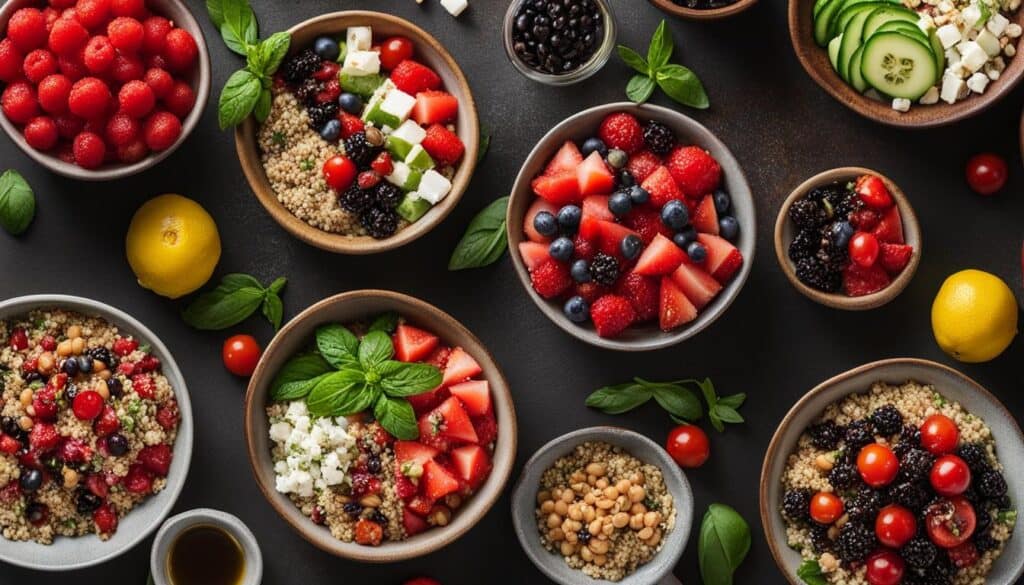
| Protein Option | Description |
|---|---|
| Chicken | Grilled or baked chicken breast is a lean protein option that adds a savory flavor to salads. |
| Fish | Flaky fish like salmon or tuna provides omega-3 fatty acids and a rich taste to complement fruits and vegetables. |
| Beans | Black beans, chickpeas, or lentils are excellent plant-based protein sources that add fiber and texture to salads. |
| Nuts | Walnuts, almonds, or cashews provide a delightful crunch and healthy fats to your salad. |
| Seeds | Sunflower seeds, chia seeds, or pumpkin seeds offer a nutritional boost with added texture and flavor. |
The Importance of Leafy Greens in Salads
When it comes to creating a nutritious and flavorful salad, leafy greens are an essential ingredient. These vibrant greens not only add color and freshness but also provide a plethora of vitamins and minerals. Darker leafy greens, such as kale and spinach, offer even greater nutritional value compared to lighter greens like iceberg lettuce.
Leafy greens are rich sources of vitamins A and C, which are vital for maintaining good health. Vitamin A promotes healthy skin and eyes, while vitamin C boosts the immune system and aids in wound healing. Additionally, leafy greens contain an array of minerals, including iron, calcium, and magnesium, which are essential for bone health and overall well-being.
By incorporating a variety of lettuces and greens into your salads, you can not only enhance the flavor but also enjoy a diverse range of nutrients. Experiment with different types of leafy greens, such as arugula, Swiss chard, and romaine lettuce, to add variety to your salads and reap the benefits of their unique nutrient profiles.
Leafy greens provide essential vitamins and minerals for a healthy salad.
Building a Nutritious and Flavorful Salad with Veggies
When it comes to creating a healthy and delicious salad, incorporating a variety of veggies is key. Not only do vegetables add nutrition, but they also bring a burst of flavor and vibrant colors to your plate. Here’s how you can build a satisfying salad using a mix of colorful produce:
Add Crunch and Freshness
Crunchy produce like carrots, cucumbers, and broccoli can add texture and freshness to your salad. These veggies not only provide a satisfying crunch but are also packed with essential vitamins and minerals. Try adding:
- Carrot sticks
- Sliced cucumbers
- Broccoli florets
Infuse Vibrancy and Antioxidants
Colorful vegetables not only make your salad visually appealing but also bring a variety of antioxidants to the table. These antioxidants help protect your body against oxidative stress and promote overall health. Consider adding:
- Cherry tomatoes
- Sliced bell peppers
- Roasted beets
| Veggie | Nutrition |
|---|---|
| Carrots | Rich in vitamin A and fiber |
| Cucumbers | Hydrating and low in calories |
| Broccoli | High in vitamin C and folate |
| Cherry tomatoes | Packed with antioxidants and vitamin C |
| Bell peppers | Excellent source of vitamin C and antioxidants |
| Roasted beets | High in fiber and beneficial plant compounds |
Add Depth and Heartiness
Leftover roasted vegetables are a fantastic addition to salads as they bring depth and heartiness to the dish. They also reduce food waste and add even more flavor to your meal. Don’t let those roasted veggies go to waste! Try adding:
- Roasted zucchini
- Roasted sweet potatoes
- Roasted cauliflower
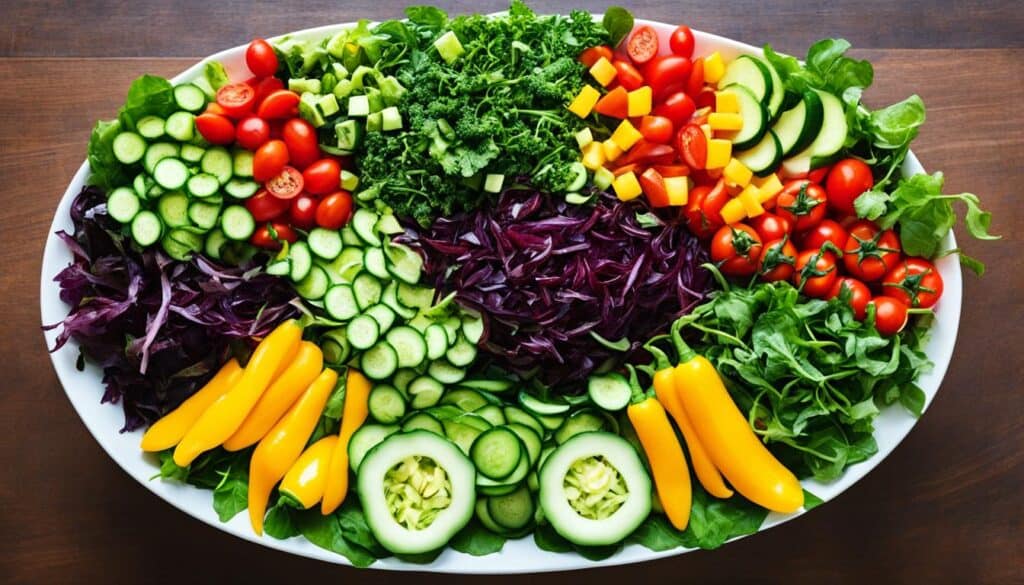
By including a variety of veggies in your salad, you not only increase the nutritional value but also create a visually appealing and flavorful dish. So, let your creativity shine and experiment with different combinations of vegetables to build your perfect salad!
Healthy Alternatives to Unhealthy Salad Toppings
Store-bought toppings like croutons and bacon bits may seem tempting to add to your salad, but they are high in salt and lack nutritional value. However, there are healthier alternatives that can still add crunch and flavor without compromising your health. Instead of reaching for those unhealthy toppings, consider incorporating the following options:
- Nuts: Nuts, such as almonds, walnuts, or pecans, are not only packed with healthy fats and protein but also provide a satisfying crunch to your salad. They add a rich, nutty flavor that pairs well with a variety of greens and dressings.
- Seeds: Seeds like chia seeds, sunflower seeds, or pumpkin seeds are a fantastic source of fiber, omega-3 fatty acids, and other essential nutrients. Sprinkling them on top of your salad can give it a delightful texture and unique taste.
- Crisp Veggies: Instead of processed toppings, why not opt for fresh and crisp vegetables? Sliced radishes, cucumbers, or bell peppers can contribute a refreshing crunch to your salad while delivering additional vitamins and minerals.
- Low-Fat Cheese: If you’re someone who enjoys the creaminess that cheese brings to a salad, consider choosing low-fat options like feta or Parmesan. These cheeses still provide the desirable richness without adding excessive calories or unhealthy fats.
By incorporating these healthy alternatives into your salad, you can elevate its nutritional value while still enjoying a variety of flavors and textures. Experiment with different combinations to find your favorite mix of toppings that make your salad both tasty and nutritious.

Adding Fruits and Nuts for Flavor and Nutrition
If you’re looking to add a burst of flavor and nutritional value to your salads, incorporating fruits and nuts is a great choice. Not only do they provide natural sweetness and crunch, but they also offer a wide range of health benefits.
Fruits: Adding fruits to your salads not only enhances their sweetness but also introduces a variety of antioxidants that promote overall health. Berries, such as strawberries and blueberries, are packed with antioxidants that help protect your cells from damage. Citrus fruits like oranges and grapefruits provide a refreshing tang and are rich in vitamin C, which supports a healthy immune system.
“The natural sweetness of fruits can elevate the flavors of your salads and provide a delightful contrast to other ingredients.” – Emily Green
Nuts: Nuts are a great addition to salads as they bring a satisfying crunch and contribute valuable protein, fiber, and healthy fats. Almonds, for example, are rich in vitamin E and provide a good source of antioxidants. Walnuts are known for their omega-3 fatty acids, which can support heart health. And if you’re looking for a nut with a milder flavor, cashews add a creamy texture without overpowering the other salad ingredients.
By pairing different fruits with specific nuts, you can create delicious and flavorful combinations that enhance your salad experience. Here are a few tasty ideas:
| Fruit | Nut |
|---|---|
| Strawberries | Almonds |
| Blueberries | Walnuts |
| Oranges | Cashews |
Experimenting with different fruit and nut combinations will not only add variety to your salads but also provide a range of nutrients that contribute to a well-balanced diet.
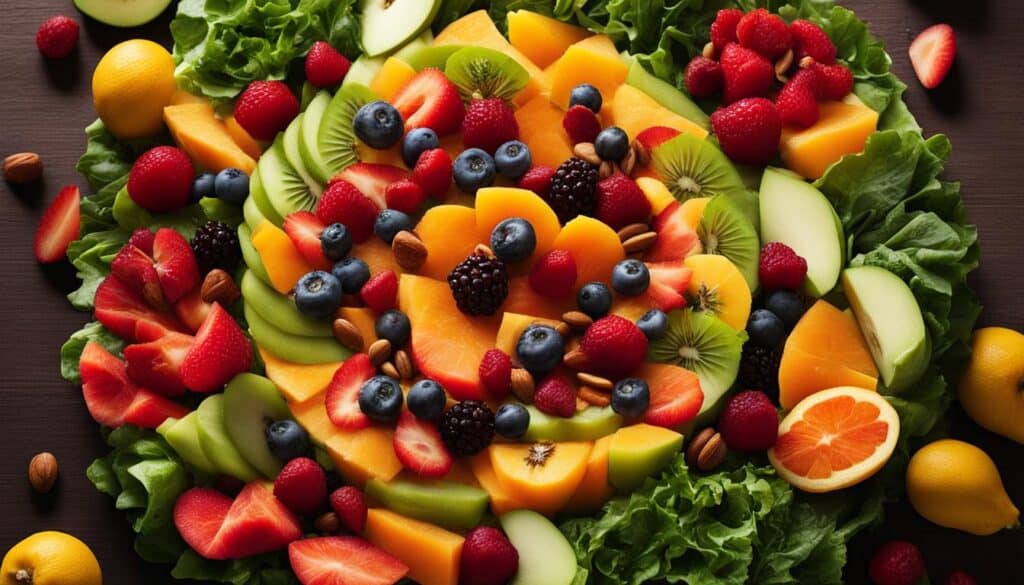
Incorporating fruits and nuts into your salads can take them from ordinary to extraordinary. Their combination of sweetness, crunch, antioxidants, protein, and fiber adds depth and flavor, making each bite a delightful experience.
Avoiding Unhealthy Salad Choices
When it comes to salads, it’s important to be mindful of your choices to ensure you’re making the healthiest option. Some salads, like Caesar salad and taco salad, can be deceivingly unhealthy due to their fried toppings, excessive dressing, and calorie-dense additions. These salads may seem like a lighter choice, but they can pack a significant amount of calories and unhealthy fats.
To make these salads a better option, consider making healthier substitutions. For example, opt for grilled chicken instead of fried chicken to reduce the amount of unhealthy fat and calories in your salad. Grilled chicken still provides protein and flavor without the negative health implications of frying.
Another way to make healthier salad choices is by watching your portions. It’s easy to pile on the dressing, but excessive dressing can quickly add up in calories and fat. Instead, drizzle a smaller amount of dressing or opt for a lighter dressing option to keep your salad nutritious and balanced.
In addition to watching the dressing, be cautious of calorie-dense additions to your salad. While toppings like croutons, bacon bits, and cheese can add flavor and texture, they also contribute to the overall calorie count. Consider healthier alternatives such as nuts, seeds, or crisp veggies to add crunch and flavor to your salad without the excessive calories.
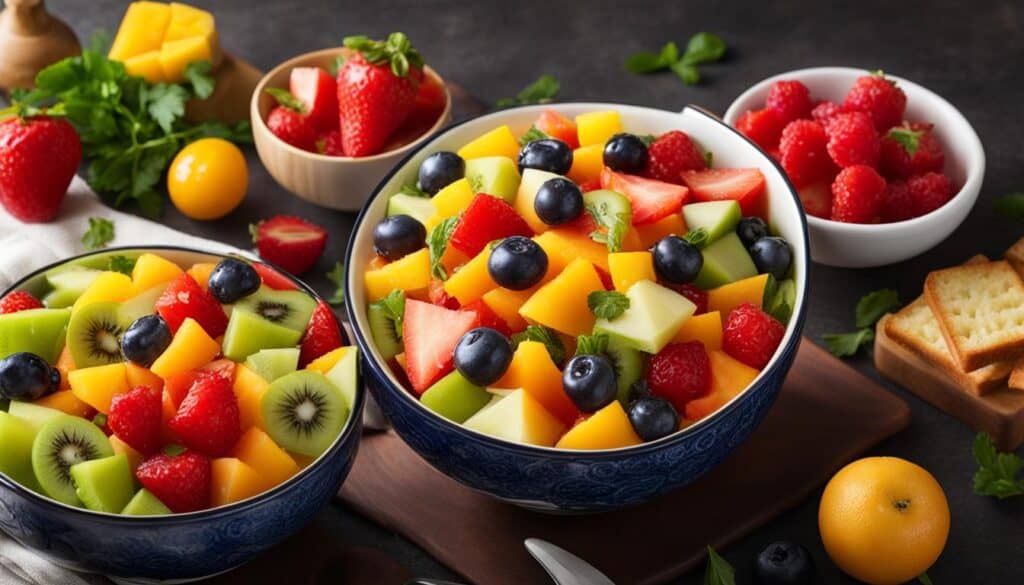
By being mindful of unhealthy salad choices, you can still enjoy a delicious and nutritious meal. Making healthier substitutions, watching portions, and opting for lighter dressings and toppings can help you create a salad that is both satisfying and beneficial for your overall health.
Conclusion
Fruit salad and vegetable salad offer a delightful and nutritious way to incorporate more healthy eating into your diet. By selecting fresh and vibrant ingredients, preparing homemade dressings, and choosing healthier toppings, salads can become a delicious and wholesome part of your everyday meals.
When it comes to building a satisfying salad, it’s essential to include a variety of fruits, vegetables, proteins, and nuts or seeds. This diverse combination not only enhances the flavor of your salad but also provides a range of essential nutrients for your overall well-being.
Remember, making mindful choices is key. Enjoy your salads as part of a balanced and healthy eating plan, alongside other nutritious foods. So, whether you prefer a fruit salad bursting with sweetness or a vegetable salad loaded with crisp greens and savory toppings, there are endless salad choices to suit your taste and dietary preferences.
FAQ
What is the difference between a fruit salad and a vegetable salad?
Fruit salad is made primarily with fruits, while vegetable salad is made primarily with vegetables. However, both can be combined to create a refreshing and nutritious mixed salad.
What defines a fruit and a vegetable?
Biologically, fruits are seed-bearing structures of plants, while all other parts like roots, stems, and leaves are considered vegetables. However, in culinary terms, fruits are often classified as sweet, while vegetables are considered savory.
What nutritional content do fruits and vegetables offer?
Fruits and vegetables are both rich in important vitamins, minerals, and antioxidants. The specific nutritional content may vary, but they are essential components of a healthy diet.
How can I make a healthier salad dressing?
Many store-bought salad dressings are high in calories, unhealthy fats, and sodium. Making your own dressing using ingredients such as olive oil, vinegar, and herbs can be a healthier option.
What toppings should I choose to make a healthy salad?
It’s important to choose toppings that add flavor and nutrition without excess calories, fat, or sodium. Opt for options like nuts, seeds, and crisp veggies instead of store-bought croutons and bacon bits.
How can I add protein to my fruit and vegetable salads?
Adding protein to salads makes them more filling and satisfying. Good sources of protein for salads include chicken, fish, beans, nuts, and seeds.
Why are leafy greens important in salads?
Leafy greens like kale and spinach are excellent sources of vitamins A and C, as well as minerals. They add nutrition and flavor to salads.
How can I build a nutritious and flavorful salad with vegetables?
Adding a variety of vegetables to your salad provides more nutrition and flavor. Choose colorful produce like tomatoes, bell peppers, and beets to add vibrancy and antioxidants.
What are some healthier alternatives to unhealthy salad toppings?
Instead of high-sodium toppings like croutons and bacon bits, opt for healthier alternatives like nuts, seeds, and crisp veggies. Choosing low-fat cheese options like feta or Parmesan can also provide creaminess without excessive calories.
How can I add fruits and nuts to enhance the flavor and nutrition of my salad?
Adding fruits to salads can provide natural sweetness and additional antioxidants. Nuts can add protein, fiber, and healthy fats, making salads more satisfying and nutritious.
How can I make healthier choices when it comes to salads?
Some salads, like Caesar salad and taco salad, can be unhealthy due to fried toppings, excessive dressing, and high-calorie additions. Making healthier substitutions, watching portions, and choosing lighter dressings can help in making healthier salad choices.

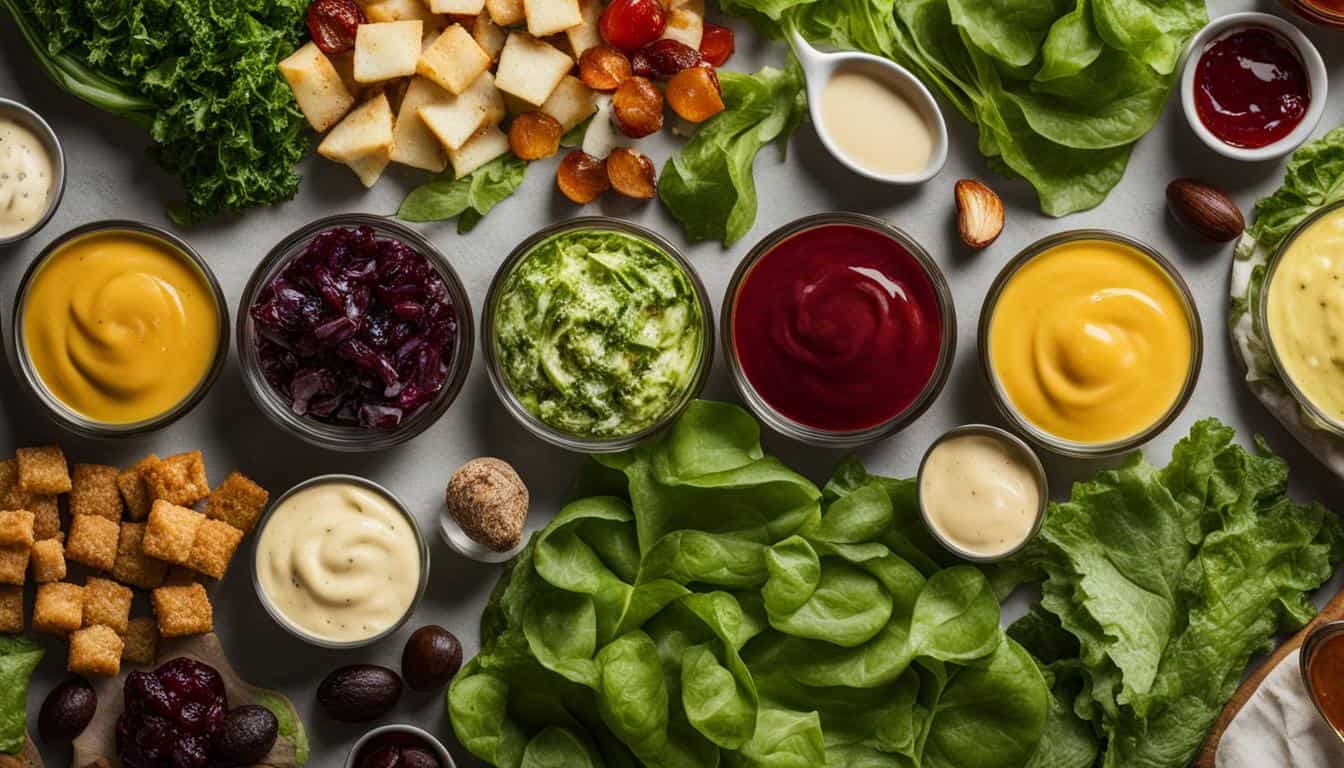



Leave a Reply